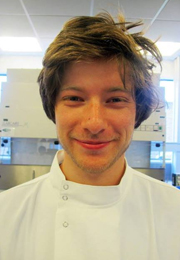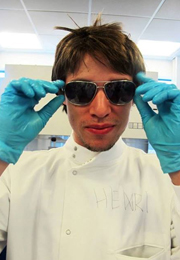Team:Exeter/Modelling
From 2013.igem.org
(→The team) |
m (Changed email, general cleaning, numbered plan, used headings) |
||
| Line 12: | Line 12: | ||
|} | |} | ||
| - | ''This page serves as a catalogue of our modelling efforts. If you have an queries or suggestions concerning this page or our modelling please email | + | ''This page serves as a catalogue of our modelling efforts. If you have an queries or suggestions concerning this page or our modelling please email igem@ex.ac.uk).'' |
| - | + | ||
| - | + | ||
== Introduction == | == Introduction == | ||
| Line 23: | Line 21: | ||
The model will focus on the rates of the reactions in our pathways and how light interacts with both the sensors and pigments. The final model will predict what colour and tone a bacteria will be given light exposure. | The model will focus on the rates of the reactions in our pathways and how light interacts with both the sensors and pigments. The final model will predict what colour and tone a bacteria will be given light exposure. | ||
| - | == The | + | == The Team == |
<gallery widths=275 heights=300> | <gallery widths=275 heights=300> | ||
| Line 33: | Line 31: | ||
We are Exeter iGEM's "dry team". Together we are responsible for the creation and development of a working model of our system. | We are Exeter iGEM's "dry team". Together we are responsible for the creation and development of a working model of our system. | ||
| - | == The | + | == The Model == |
| - | + | ||
| - | + | ||
| + | === Assumptions === | ||
Due to the complexity of biological systems our model will include but not be limited to the following assumptions: | Due to the complexity of biological systems our model will include but not be limited to the following assumptions: | ||
* Classical elastic mechanics | * Classical elastic mechanics | ||
| - | |||
* Bacteria contain a homogeneous mix of components | * Bacteria contain a homogeneous mix of components | ||
| - | |||
* All constituents move with brownian motion | * All constituents move with brownian motion | ||
| - | |||
* Bacteria are identical | * Bacteria are identical | ||
| - | |||
* Bacteria evenly distributed across surface | * Bacteria evenly distributed across surface | ||
| - | |||
* Bacteria do not interact | * Bacteria do not interact | ||
| - | |||
* Only pathway specific species are rate limiting | * Only pathway specific species are rate limiting | ||
| - | + | === The Plan === | |
| - | + | ||
| - | + | ||
| - | + | ||
| - | + | ||
| - | + | ||
| - | + | ||
| - | + | # The chemistry of our pathways are to be mapped out in detail. | |
| + | # We will research what relevant models exist and make use of the most accurate. | ||
| + | # We shall construct rudimentary equations for each step in our pathways. | ||
| + | # Throughout the project our model will be updated either in light of experimental results or new ideas. | ||
Revision as of 15:31, 15 July 2013
| Home | Team | Official Team Profile | Project | Parts Submitted to the Registry | Modelling | Notebook | Safety | Attributions |
|---|
This page serves as a catalogue of our modelling efforts. If you have an queries or suggestions concerning this page or our modelling please email igem@ex.ac.uk).
Contents |
Introduction
We aim to produce an extensive model that predicts the behavior of our system. The purpose of this model is to numerically characterize our bio-bricks for future use.
The model will focus on the rates of the reactions in our pathways and how light interacts with both the sensors and pigments. The final model will predict what colour and tone a bacteria will be given light exposure.
The Team
We are Exeter iGEM's "dry team". Together we are responsible for the creation and development of a working model of our system.
The Model
Assumptions
Due to the complexity of biological systems our model will include but not be limited to the following assumptions:
- Classical elastic mechanics
- Bacteria contain a homogeneous mix of components
- All constituents move with brownian motion
- Bacteria are identical
- Bacteria evenly distributed across surface
- Bacteria do not interact
- Only pathway specific species are rate limiting
The Plan
- The chemistry of our pathways are to be mapped out in detail.
- We will research what relevant models exist and make use of the most accurate.
- We shall construct rudimentary equations for each step in our pathways.
- Throughout the project our model will be updated either in light of experimental results or new ideas.
 "
"


